
A terrarium is a glass container containing soil and plants in an environment different from the surroundings. It is usually a sealable container that can be opened for maintenance or to access the plants inside; however, terraria can also be open to the atmosphere. Terraria are often kept as ornamental items.

Bonsai is the Japanese art of growing and shaping miniature trees in containers, with a long documented history of influences and native Japanese development over a thousand years, and with unique aesthetics, cultural history, and terminology derived from its evolution in Japan. Similar arts exist in other cultures, including Korea's bunjae, the Chinese art of penjing, and the miniature living landscapes of Vietnamese Hòn non bộ.
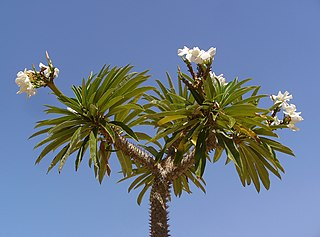
Pachypodium lamerei is a species of flowering plant in the family Apocynaceae. It is a stem succulent, photosynthesizing mainly through its trunk, and comes from the island of Madagascar, off the east coast of Africa. It has large thorns and leaves mostly just at the top of the plant, and large, fragrant flowers. The species has become one of the best known pachypodiums in cultivation, being relatively easy to propagate and grow. In cultivation it is often marketed as the Madagascar palm, despite its not being a palm at all. A variety called "Ramosum" has been described. It is distinguished mostly by a dwarf growth habit and its more rounded corolla lobe.
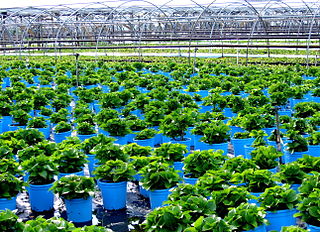
A nursery is a place where plants are propagated and grown to a desired size. Mostly the plants concerned are for gardening, forestry, or conservation biology, rather than agriculture. They include retail nurseries, which sell to the general public; wholesale nurseries, which sell only to businesses such as other nurseries and commercial gardeners; and private nurseries, which supply the needs of institutions or private estates. Some will also work in plant breeding.
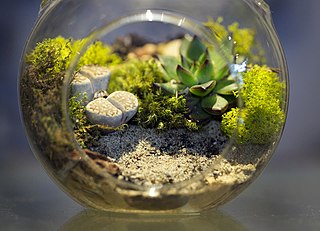
A vivarium is an area, usually enclosed, for keeping and raising animals or plants for observation or research. Water-based vivaria may have open tops providing they are not connected to other water bodies. An animal enclosure is considered a vivarium only if it provides quality of life through naturalistic components such as ample living space and natural decor that allow and encourage natural behaviours. Often, a portion of the ecosystem for a particular species is simulated on a smaller scale, with controls for environmental conditions such as temperature, humidity and light.

A houseplant, sometimes known as a pot plant, potted plant, or an indoor plant, is an ornamental plant that is grown indoors. As such, they are found in places like residences and offices, mainly for decorative purposes. Common houseplants are usually tropical or semi-tropical, and are often epiphytes, succulents or cacti.

Penjing, also known as penzai, is the ancient Chinese art of depicting artistically formed trees, other plants, and landscapes in miniature.

Layering is a vegetative propagation technique where the stem or branch of a plant is manipulated to promote root development while still attached to the parent plant. Once roots are established, the new plant can be detached from the parent and planted. Layering is utilized by horticulturists to propagate desirable plants.

Hoya carnosa, the porcelainflower or wax plant, is a species of flowering plant in the family Apocynaceae, native to East Asia. It is a common house plant grown for its attractive waxy foliage, and sweetly scented flowers. It is grown well in pots and hanging baskets.
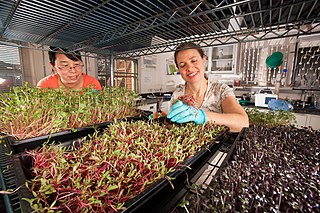
Microgreens are vegetable greens harvested just after the cotyledon leaves have developed with one set of true leaves. They are used as a visual, flavor and texture enhancement. Microgreens are used to add sweetness and spiciness to foods. Microgreens are smaller than "baby greens" because they are harvested soon after sprouting, rather than after the plant has matured to produce multiple leaves.

A flowerpot, planter, planterette or plant pot, is a container in which flowers and other plants are cultivated and displayed. Historically, and still to a significant extent today, they are made from plain terracotta with no ceramic glaze, with a round shape, tapering inwards. Flowerpots are now often also made from plastic, metal, wood, stone, or sometimes biodegradable material. An example of biodegradable pots are ones made of heavy brown paper, cardboard, or peat moss in which young plants for transplanting are grown.

Chrysalidocarpus lutescens, also known by its synonym Dypsis lutescens and as golden cane palm, areca palm, yellow palm, butterfly palm, or bamboo palm, is a species of flowering plant in the family Arecaceae, native to Madagascar and naturalized in the Andaman Islands, Thailand, Vietnam, Réunion, El Salvador, Cuba, Puerto Rico, the Canary Islands, southern Florida, Haiti, the Dominican Republic, Jamaica, the Leeward Islands and the Leeward Antilles. Its native names are rehazo and lafahazo.

Akadama is a naturally occurring, granular clay-like mineral used as soil for bonsai trees and other container-grown plants. It is surface-mined, immediately sifted and bagged, and supplied in various grades; the deeper-mined grade are somewhat harder and more useful in horticulture than the more softer, shallow-mined grades. Akadama may also act as one component of growing medium when combined with other elements such as sand, composted bark, peat, or crushed lava. The color darkens when moist which can help the grower determine when to water a tree.
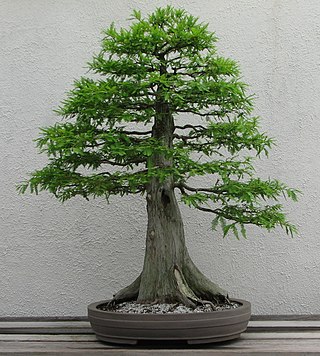
Bonsai aesthetics are the aesthetic goals and characteristics of the Japanese tradition of the art of bonsai, the growing of a miniature tree in a container. Many Japanese cultural characteristics, particularly the influence of Zen Buddhism and the expression wabi-sabi inform the bonsai tradition in that culture. A lengthy catalog of conventional tree shapes and styles also helps provide cohesion to the Japanese styling tradition. A number of other cultures around the world have adopted the Japanese approach to bonsai, and while some variations have begun to appear, most hew closely to the rules and design philosophies of the Japanese tradition.

Indoor bonsai are bonsai cultivated for the indoor environment. Traditionally, bonsai are temperate climate trees grown outdoors in containers. Tropical and sub-tropical tree species can be cultivated to grow and thrive indoors, with some suited to bonsai aesthetics shaped as traditional outdoor or wild bonsai.
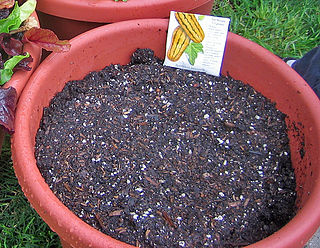
Potting soil or growing media, also known as potting mix or potting compost (UK), is a substrate used to grow plants in containers. The first recorded use of the term is from an 1861 issue of the American Agriculturist. Despite its name, little or no soil is usually used in potting soil.

Bonsai cultivation and care involves the long-term cultivation of small trees in containers, called bonsai in the Japanese tradition of this art form. Similar practices exist in other Japanese art forms and in other cultures, including saikei (Japanese), penjing (Chinese), and hòn non bộ (Vietnamese). Trees are difficult to cultivate in containers, which restrict root growth, nutrition uptake, and resources for transpiration. In addition to the root constraints of containers, bonsai trunks, branches, and foliage are extensively shaped and manipulated to meet aesthetic goals. Specialized tools and techniques are used to protect the health and vigor of the subject tree. Over time, the artistic manipulation of small trees in containers has led to a number of cultivation and care approaches that successfully meet the practical and the artistic requirements of bonsai and similar traditions.
There are many ways to garden in restricted spaces. Often a small or limited space is an issue in growing and cultivating plants. Restricted space gardens can be located on small lawns, balconies, patios, porches, rooftops, inside the home, or in any other available place. Gardening in small places can be applied to edible or floral plants. Growing food has many benefits including saving money; healthier, fresher, and better tasting food; knowledge of pesticide and fertilizer exposure. Gardening is a good form of exercise and has been proven to be therapeutic.

Bonsai is a Japanese art form using trees grown in containers. Similar practices exist in other cultures, including the Chinese tradition of penjing from which the art originated, and the miniature living landscapes of Vietnamese hòn non bộ. The term "bonsai" itself is a Japanese pronunciation of the earlier Chinese term penzai. The word bonsai is often used in English as an umbrella term for all miniature trees in containers or pots. This article focuses on the history of bonsai in Japan and, in modern times, worldwide.

Senecio tropaeolifolius, which is known as false nasturtium or nasturtium-leaf spearhead is a succulent plant in the family Asteraceae that is native to South Africa.




















